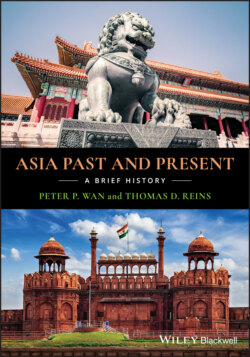Читать книгу Asia Past and Present - Peter P. Wan - Страница 24
Ancient Chinese Civilization
ОглавлениеAs in the other ancient civilizations of Mesopotamia, Egypt, and the Indus Valley, the initial stages of civilization in China originated in a dry region with easily worked soil near a large river. The Yellow River and its tributaries supplied both sufficient water for irrigation and regular annual flooding that deposited new topsoil on existing fields, an agricultural combination that generated the abundant harvests capable of supporting a large non‐farming population. Exactly how and where Chinese civilization began is unclear, but social scientists generally agree that just after 2000 BCE a complex culture capable of constructing public buildings, crafting writing, using bronze, mobilizing manpower, and domesticating horses for chariot warfare and other tasks appeared in the vicinity of the Yellow River. As in the case of India, questions arise about whether Chinese civilization started on its own or if it owed its creation or at least much of its development to outside influences. Thus, the chariot and its similarity to those in other parts of Eurasia seem to indicate external contact. There is also dispute as to whether China’s first historical dynasty, the Shang (ca. 1650–1050 BCE), in fact was preceded by an earlier dynasty. Growing evidence indicates the likelihood of an earlier dynasty the Chinese call the Xia.
Whatever future research authenticates, current evidence reveals the existence of a Shang Dynasty by at least the seventeenth century BCE, probably headquartered in today’s Henan Province but extending across a good part of the North China Plain. An emperor or king, whose functions appear to have been both political and religious, presided over a central government. This ruler likely had to share power with a rural landowning elite but nevertheless could mobilize manpower and materials for numerous projects. Some of the larger undertakings included the building of palaces, city walls, and burial facilities for rulers, as well as the deployment of a host of talent that would organize laborers and artisans to construct the facilities. Priestly advisors or diviners or shamans provided the ruler with insight about the supernatural, chiefly by interpreting cracks on oracle bones. Since the ruler was linked to the supreme deity, he needed to know what to do or refrain from doing. Upsetting god might well result in one’s government itself being upset.
The Shang Dynasty established the initial foundation for the ideal of central government in China that survives in amended form down to the twenty‐first century. This central government model did not always operate successfully, failing to some extent between dynasties for greater or lesser periods of time. Unsuccessful central government rule occurred during times when dynasties were headed by weak rulers or when China’s neighbors, usually nomadic ones to the north, invaded and temporarily took control. The principle of central direction orchestrated by rulers connected to divinity typically remained a Chinese political and intellectual ideal. By contrast, India seldom experienced central government rule by Indians. With the exception of two dynasties, the Mauryan (321–185 BCE) and the Gupta (320–540 CE), India either remained fragmented, governed by regional monarchs and lesser rulers—think of splintered Europe after the fall of the Roman Empire—or was ruled by foreigners until independence from Britain in 1947.
